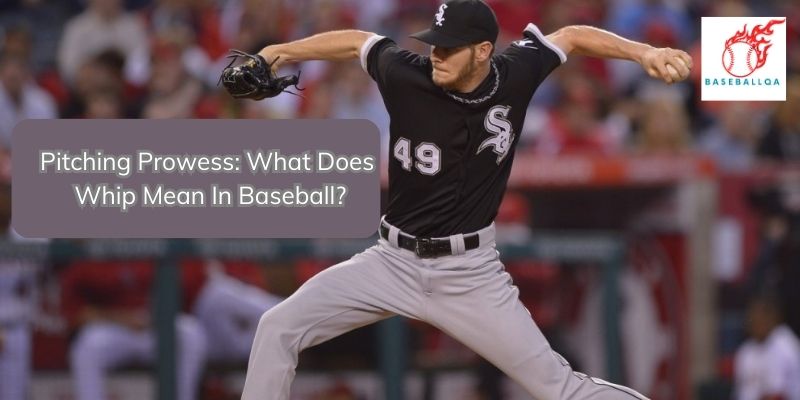One term that sticks out on the pitcher’s mound in the complex language of baseball statistics, where numbers tell tales and measures form opinions, is “What does whip mean in baseball? “Why is it such an important number for assessing a pitcher’s effectiveness? We’ll discuss the significance of the “WHIP,” how it measures a pitcher’s effectiveness and control, and why it’s a crucial metric for both players and spectators.
What does Whip mean in baseball?

It is a straightforward statistic that determines how many hits and walks a pitcher allows on average. This can be used to predict whether or not a pitcher will allow runs. Each baserunner is a potential run.
David Okrent invented it in 1979 as a simple and uncomplicated measure. WHIP was formerly known as IPRAT, which stood for Innings Pitched Ratio. In rotisserie fantasy baseball, the metric was used to score and make predictions. By the 1990s, it had become widely accepted baseball jargon.
WHIP calculation
The WHIP calculation is (Walks + Hits)/Innings Pitched. Simply tally up the amount of hits and walks allowed by a pitcher over the course of a season and divide it by the total number of innings pitched. As a result, the greater the value, the worse the pitcher is thought to be, and vice versa.
For example, if a pitcher allowed 50 hits and 20 walks over 50 innings, you would add 50 and 20 to get 70, then divide by 50 to get a WHIP of 1.4.
WHIP Evaluation
A good WHIP, according to popular opinion, is less than 1.1—one run scored and one base. By this metric, an outstanding WHIP is less than 1. It is crucial to note that WHIP is not as volatile as other baseball statistics. In other words, the WHIP bar does not alter from year to year. The average WHIP in MLB is 1.30, and any WHIP above 1.50 is considered terrible.
Pitchers are meant to keep runners off the bases. As a result, pitchers with a low WHIP are often the best.
What does WHIP not measure?

You should be aware that WHIP is not an accurate assessment for all baserunners. WHIP solely considers walks and hits. However, if a player gets hit by a pitch, that is not covered. Batters who reach base due to a fielding or throwing error are not counted.
Baserunners who get on due to a fielder’s choice are also not counted. WHIP also does not indicate how many bases a pitcher gives up. In WHIP, a single, double, triple, or homer all count as the same type of hit. So, if you have a pitcher who gives up a lot of walks and another who gives up a lot of triples, they may have the same WHIP.
Why is a WHIP effective?
The more effective pitchers will have a lower WHIP, as seen by the WHIP data. A pitcher that allows more baserunners has a higher WHIP. The more baserunners you have, the more opportunities there are to score. Lower WHIP pitchers typically allow fewer baserunners and runs.
Is WHIP a reliable predictor of a pitcher’s performance?
A pitcher’s WHIP is a reliable predictor of their effectiveness. It is not the only statistic employed to gauge a pitch’s effectiveness. However, a pitcher’s WHIP is a reliable predictor of their performance. A greater possibility of success exists if fewer runners are left on base. You should combine WHIP and ERA to assess a pitcher more accurately.
How well does WHIP predict success?

The relationship between WHIP and wins is significant. It is more challenging for the opposing team to score the less baserunners you allow. Reduce the number of runs the opposing side scores to increase your chances of winning. A pitcher’s control is well-represented by a reduced WHIP, which is what you want. A high WHIP indicates that a pitcher lacks control and is likely walking hitters or giving up hits.
WHIP does not take fielding errors and offensive production into account. This means that even if your pitcher may be incredibly effective, your defense may be weak. There are various exceptions, even if there is a correlation.
What Distinctions Can Be Made Between ERA and WHIP?
Common pitching statistics include earned run average (ERA) and walk plus hits per inning pitched (WHIP). In other words, if a player has a low ERA, he probably also has a low WHIP because they are correlated with one another. As long as the runners reach the bases after the error, the WHIP still counts; in other words, it is unimportant how the runners reach base.
Many people believe that the WHIP is a superior isolation statistic to the ERA for assessing the pitcher because it measures specific occurrences like walks, hits, and innings. The Earned Run Average metric, on the other hand, keeps track of the circumstances that, frequently, are not totally under the pitcher’s control.
Conclusion
When it comes to orchestrating the story of a pitcher’s prowess at navigating the nuances of strikes and balls, “WHIP” is a master. It is a metric that goes beyond the straightforward counting of walks and hits; it is a complex reflection of a pitcher’s effectiveness, command of the game, and influence on the diamond and comprehension ‘WHIP’ as spectators, athletes, and analysts deepens our comprehension of the tactical dance between pitcher and batter. It reveals the skill that goes into each pitch, the dexterity in limiting walks and hits, and the methodical technique that determines a pitcher’s ability.


